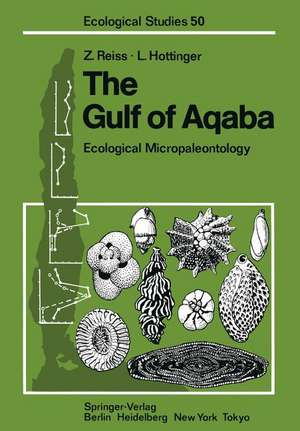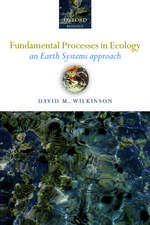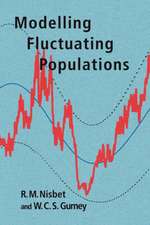The Gulf of Aqaba: Ecological Micropaleontology: Ecological Studies, cartea 50
Autor Zeev Reiss, Lukas Hottingeren Limba Engleză Paperback – 5 dec 2011
Din seria Ecological Studies
- 18%
 Preț: 1118.93 lei
Preț: 1118.93 lei -
 Preț: 553.72 lei
Preț: 553.72 lei - 18%
 Preț: 1680.55 lei
Preț: 1680.55 lei - 18%
 Preț: 1003.38 lei
Preț: 1003.38 lei - 20%
 Preț: 1004.71 lei
Preț: 1004.71 lei -
 Preț: 480.62 lei
Preț: 480.62 lei - 5%
 Preț: 752.26 lei
Preț: 752.26 lei - 15%
 Preț: 643.99 lei
Preț: 643.99 lei - 15%
 Preț: 644.18 lei
Preț: 644.18 lei - 15%
 Preț: 652.49 lei
Preț: 652.49 lei - 18%
 Preț: 789.83 lei
Preț: 789.83 lei -
 Preț: 382.36 lei
Preț: 382.36 lei - 15%
 Preț: 643.48 lei
Preț: 643.48 lei - 15%
 Preț: 646.30 lei
Preț: 646.30 lei - 15%
 Preț: 634.32 lei
Preț: 634.32 lei -
 Preț: 384.86 lei
Preț: 384.86 lei - 18%
 Preț: 789.98 lei
Preț: 789.98 lei - 15%
 Preț: 645.14 lei
Preț: 645.14 lei - 15%
 Preț: 649.39 lei
Preț: 649.39 lei - 18%
 Preț: 1005.43 lei
Preț: 1005.43 lei - 18%
 Preț: 949.23 lei
Preț: 949.23 lei - 15%
 Preț: 649.54 lei
Preț: 649.54 lei - 15%
 Preț: 643.34 lei
Preț: 643.34 lei - 15%
 Preț: 649.71 lei
Preț: 649.71 lei - 15%
 Preț: 638.76 lei
Preț: 638.76 lei - 18%
 Preț: 957.62 lei
Preț: 957.62 lei - 18%
 Preț: 1235.25 lei
Preț: 1235.25 lei - 18%
 Preț: 962.18 lei
Preț: 962.18 lei - 18%
 Preț: 949.23 lei
Preț: 949.23 lei - 15%
 Preț: 660.68 lei
Preț: 660.68 lei -
 Preț: 397.76 lei
Preț: 397.76 lei - 15%
 Preț: 638.24 lei
Preț: 638.24 lei - 18%
 Preț: 942.31 lei
Preț: 942.31 lei - 18%
 Preț: 1232.57 lei
Preț: 1232.57 lei - 15%
 Preț: 651.34 lei
Preț: 651.34 lei - 18%
 Preț: 952.72 lei
Preț: 952.72 lei - 18%
 Preț: 1834.27 lei
Preț: 1834.27 lei - 18%
 Preț: 1229.10 lei
Preț: 1229.10 lei -
 Preț: 423.95 lei
Preț: 423.95 lei - 18%
 Preț: 948.92 lei
Preț: 948.92 lei
Preț: 646.43 lei
Preț vechi: 760.50 lei
-15% Nou
Puncte Express: 970
Preț estimativ în valută:
123.71€ • 134.33$ • 103.92£
123.71€ • 134.33$ • 103.92£
Carte tipărită la comandă
Livrare economică 22 aprilie-06 mai
Preluare comenzi: 021 569.72.76
Specificații
ISBN-13: 9783642697890
ISBN-10: 3642697895
Pagini: 368
Ilustrații: VIII, 356 p.
Dimensiuni: 170 x 244 x 19 mm
Greutate: 0.59 kg
Ediția:Softcover reprint of the original 1st ed. 1984
Editura: Springer Berlin, Heidelberg
Colecția Springer
Seria Ecological Studies
Locul publicării:Berlin, Heidelberg, Germany
ISBN-10: 3642697895
Pagini: 368
Ilustrații: VIII, 356 p.
Dimensiuni: 170 x 244 x 19 mm
Greutate: 0.59 kg
Ediția:Softcover reprint of the original 1st ed. 1984
Editura: Springer Berlin, Heidelberg
Colecția Springer
Seria Ecological Studies
Locul publicării:Berlin, Heidelberg, Germany
Public țintă
ResearchCuprins
A. Introduction.- A.1 Background and History of Research.- A.2 List of Participants and Their Contributions.- A. 3 Purpose of the Book.- B. Synopsis.- C. The Gulf of Aqaba — a Rift-Shaped Depression.- D. A Desert-Enclosed Sea.- D.1 Climate.- D.2 Hydrography.- D.3 Circulation Pattern.- D.4 Seasonality.- D.5 Nutrients.- D.6 Primary Production.- D.7 Composition of Plankton.- D.8 Light.- D.9 Characteristics of Water Masses.- E. Shell Producers in the Water Column.- E.1 Calcareous Plankton.- E.2 Coccolithophorida.- E.3 Foraminiferida.- E.4 Pteropoda.- E.5 Aqaba Calcareous Plankton: Significance and Problems.- F. The Sea Bottom — a Mosaic of Substrates.- F.1 Methods of Investigation.- F.2 Selected Areas.- F.3 Significance of the Depth Gradient.- F.4 Significance of Substrates.- F.5 Seasonality.- G. Benthic Foraminifera: Response to Environment.- G.1 Larger Foraminiferans.- G.2 “Smaller” Benthic Foraminifera.- G.3 Significance of Shell Morphogenesis.- G.4 Significance of Symbiosis.- G.5 Stable Isotopes and Related Problems.- G.6 Thanatocoenoses.- H. 150,000 Years Gulf of Aqaba.- H.1 Deep Sea Cores.- H.2 Microfossil Assemblages from Cores.- H.3 Stratigraphy.- H.4 Paleoenvironments.- H.5 Paleoceanographic History.- References.- Taxonomic Index.
















